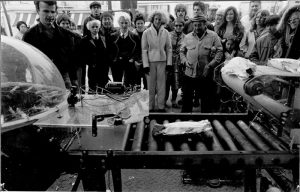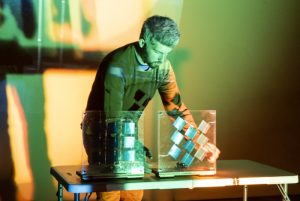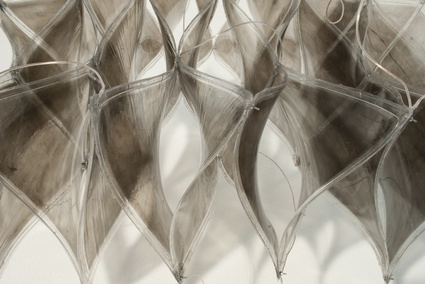
A collaboration between the chair for Computer Aided Architectural Design (ETHZ) and the Swiss Federal Laboratories for Materials Science and Technology (EMPA), ShapeShift explores the potential application of electro-active polymer at an architectural scale.
Electro-active polymer is an ultra-lightweight, flexible material that can change shape without the need for mechanical actuators and acts like the living, supple skin of a building. Responsive environments or spaces can be created that dynamically adapt to external influences.
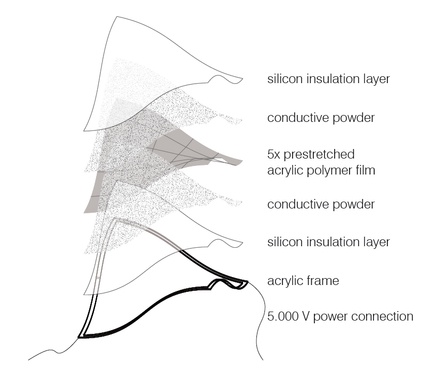
One doesn’t run from one architecture biennale to another without hearing about electroactive polymers. I’m ashamed to admit that i had never taken the time to look deeper into their potential, challenges and promises. Until life threw Manuel Kretzer my way. Kretzer is an architect, designer and Scientific Assistant at the Chair for CAAD, ETH Zürich. Together with Edyta Augustinowicz, Sofia Georgakopoulou, Dino Rossi and Stefanie Sixt, he has developed a prototype of EAP. I’ve asked him to give us more details about the development of ShapeShift and to share his thoughts about the new spatial experiences that electroactive polymers could bring about.
What makes ShapeShift stand apart from other existing high-tech Electroactive Polymers?
Mostly scale and visual appearance. We’re using the material’s properties not merely as an actuator replacement but are emphasizing its aesthetic qualities. The thin film functions as a possible alternative for conventional building skins and envisions the concept of a soft and responsive architecture. The component based form results from the material’s desire to return into its original shape combined with specially designed flexible frames. This minimum energy structure retains a variable stiffness, which allows for a variety of deformations within a given range.
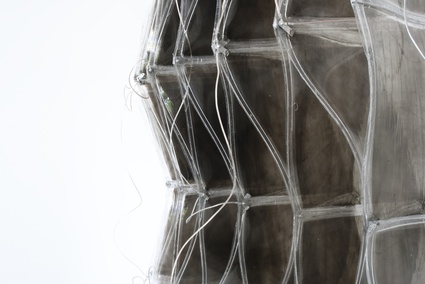
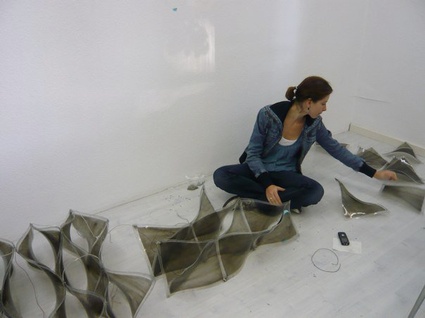 Which kind of real world applications do you foresee for ShapeShift? In design? Architecture? Other areas of everyday life?
Which kind of real world applications do you foresee for ShapeShift? In design? Architecture? Other areas of everyday life?
We are now looking into possibilities (and funding) to continue this research on a larger scale. The concept of independent devices, networked together and affecting each other’s behavior can easily be combined with computational approaches to collaborative intelligence and self-organization. In combination with further transformational materials, sensors and embedded control units this can allow the creation of complex and smart environments that dynamically adapt to external influences and physically respond to human inputs. Electro-active polymers have the potential to replace existing mechanical actuators such as motors or hydraulics, and at the same time can become aesthetically interesting, visible and structural elements that lead to new spatial experiences.
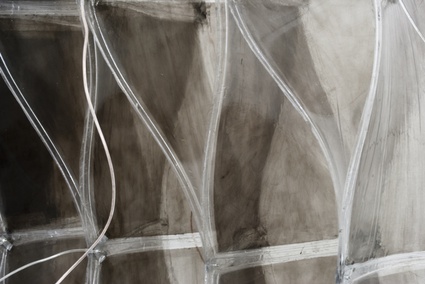 Now if you could go wild and imagine what ShapeShift could do in a scifi-esque context, where would it be applied?
Now if you could go wild and imagine what ShapeShift could do in a scifi-esque context, where would it be applied?
If ShapeShift could evolve further and become a truly independent, component based, extremely thin and flexible but still insulating, harmless, translucent (maybe partly transparent) and responsive structural skin without the need of external “backbones” or supports then this could replace every facade, ceiling, floor, door, window or even furniture.
More thin film materials like PV cells, OLEDs, Aerogels, “phase change materials” or “self healing materials” could be included. This soft membrane could then take any desired shape and retain it for as long as desired. Wall segments could open, close, rise or shrink, change opacity and appearance or join with other segments to form new spaces. If this “organism” had a collective intelligence and would be shape shifting without us realizing it, this could be a solution for overpopulation and the distribution of space in (a far) future. Rooms would only emerge where and when they are needed and spaces of any size, shape and appearance could be generated.
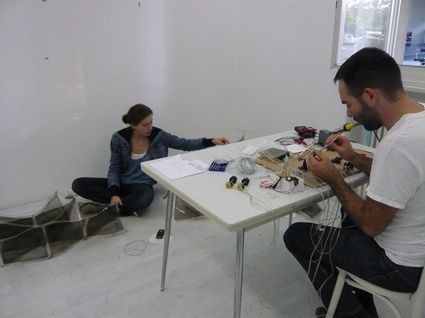 ShapeShift was recently exhibited at Starkart in Zürich. What were the answers from the general public and the professionals from the field?
ShapeShift was recently exhibited at Starkart in Zürich. What were the answers from the general public and the professionals from the field?
Reactions at the Vernissage were extremely positive. The visitors were fascinated by the “organic”, smooth and completely silent movement of the sculpture. Unfortunately the components are still very weak and fragile so by the end a few of them were broken. Professionals from the EAP field were very impressed by the students rigor and enthusiasm and what they achieved in this very short time. They liked that the aesthetic sides of the material were emphasized as this hasn’t been taken into account so far. The installation is now shown at the Schweizer Baumuster Zentrale.
If you could have your pick and leave ShapeShift into the hands of a renowned architect (or several) of your choice? Who would it be? Who do you think would best exploit its qualities?
I can’t name anyone specific. In the 60s and 70s there were big visionaries like Archigram, Constant or Kiesler who experimented with new materials, technologies and forms. I think a similar playful and radical creativity would be necessary to use the material in a way that it really generates something new and unique.
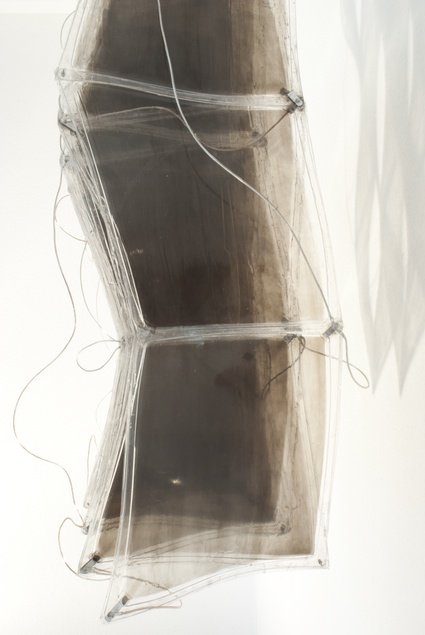 Do ShapeShift and other Electroactive Polymers make sense in a world that should be more and more worried about ecology?
Do ShapeShift and other Electroactive Polymers make sense in a world that should be more and more worried about ecology?
EAPs are in principle capacitors. So the energy that is needed to actuate them could in theory be reused in a closed loop. Also technologies to harvest renewable resources are constantly evolving. I don’t know enough about the manufacturing process of the materials components or their recyclability to judge whether they are sustainable or not.
Would it be cost prohibitive to apply ShapeShift to the scale of a whole building today?
So far EAPs are still far from mature. The components are very expensive and the process of making them long and difficult. They are very fragile and their longevity is restricted. Also due to the high voltage they are a bit dangerous.
If there was a true interest in using this material at a larger scale I think the manufacturing could be automated and the insulation improved. With a rising demand also the costs for the individual components would sink.
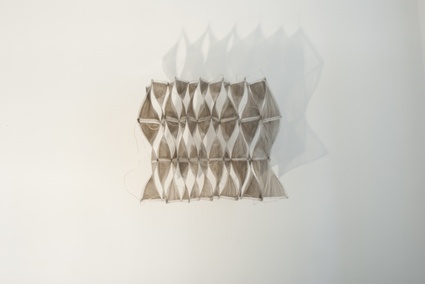 Can you explain us the involvement of CAAD, ETH Zürich in the development of Shapeshift? And what was the role of the students exactly? Were they involved throughout the development of ShapeShift or only when it came to develop prototypes and applications?
Can you explain us the involvement of CAAD, ETH Zürich in the development of Shapeshift? And what was the role of the students exactly? Were they involved throughout the development of ShapeShift or only when it came to develop prototypes and applications?
My personal research at the Chair for CAAD focuses on the application and integration of new, “smart” materials and technologies into architecture. Therefore I established contact to the EAP research facility at the Swiss Federal Laboratories for Materials Science and Technology (EMPA) in Dübendorf, close to Zürich. The complete physical and conceptional development of the project was a cooperation of a team of MAS (Master of Advanced Studies, a postgraduate program at our Chair) students, namely Edyta Augustynowicz, Sofia Georgakopulou, Dino Rossi and Stefanie Sixt and was closely supervised by me. The students executed endless experiments at the EMPA research facility – with support from the people there – and from this knowledge a dynamic structure evolved. The installation was then presented to members of the chair and the public.
Thanks Manuel!


